“Pre-Earthquake” Micro-Structural Effects Induced by Shear Stress on α-Quartz in Laboratory Experiments
Abstract
1. Introduction
2. Materials and Methods
3. Results
4. Discussion of Results and Conclusions
Author Contributions
Funding
Acknowledgments
Conflicts of Interest
Appendix A
Analysis of Friction Coefficients in a Vibrating Cup Mill (Ring Mill)
- (1)
- friction from slipping (grinding bodies that slip on the jar’s flat surfaces);
- (2)
- rolling friction (grinding bodies which, if coupled, roll into each other).
- (1)
- the main rotation signal (jar, ωl);
- (2)
- signals due to the internal grinding masses (ring, ω2, and ω2ε, and cylinder, ω3, and ω4)—the signal harmonics up to a few kHz of frequency.
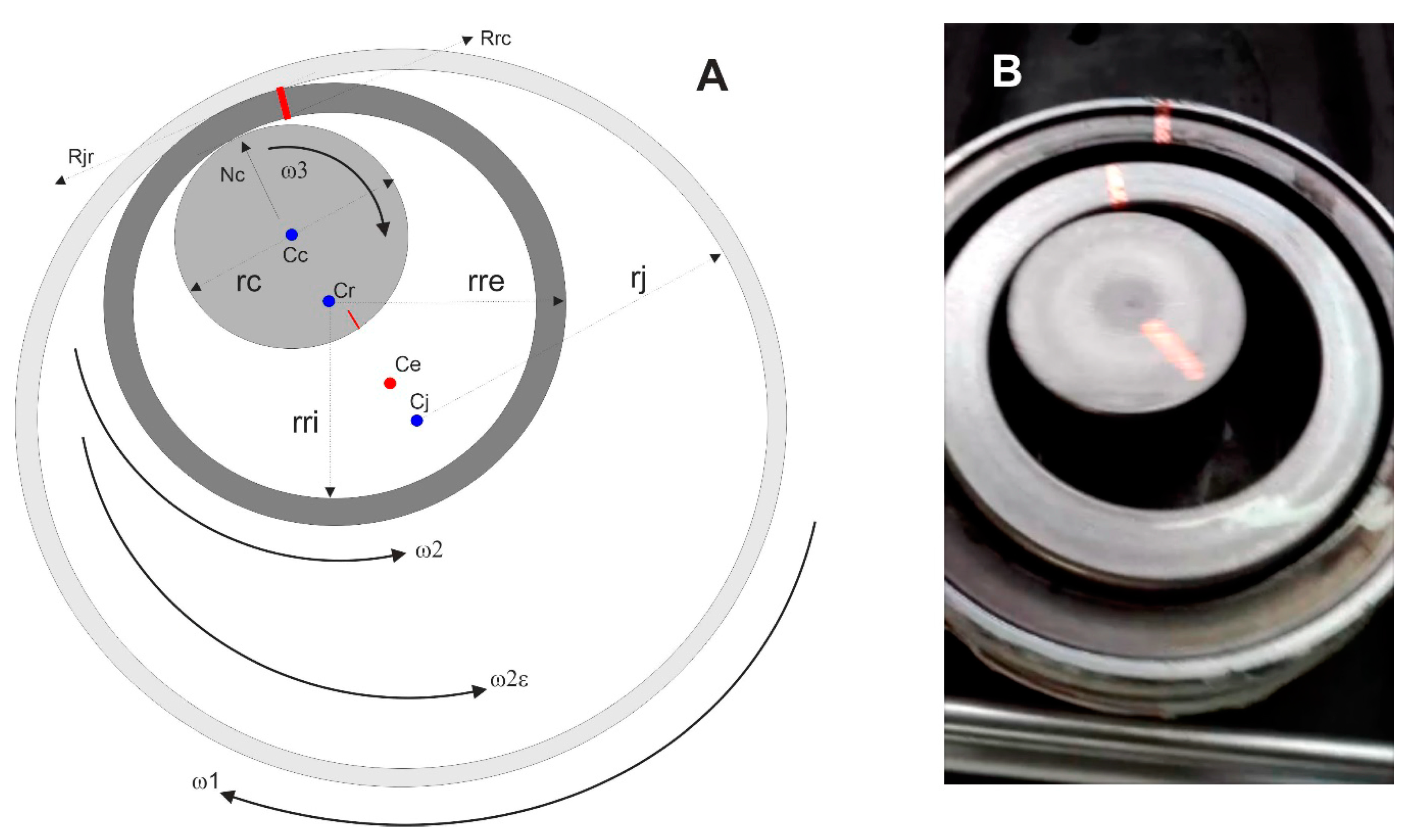
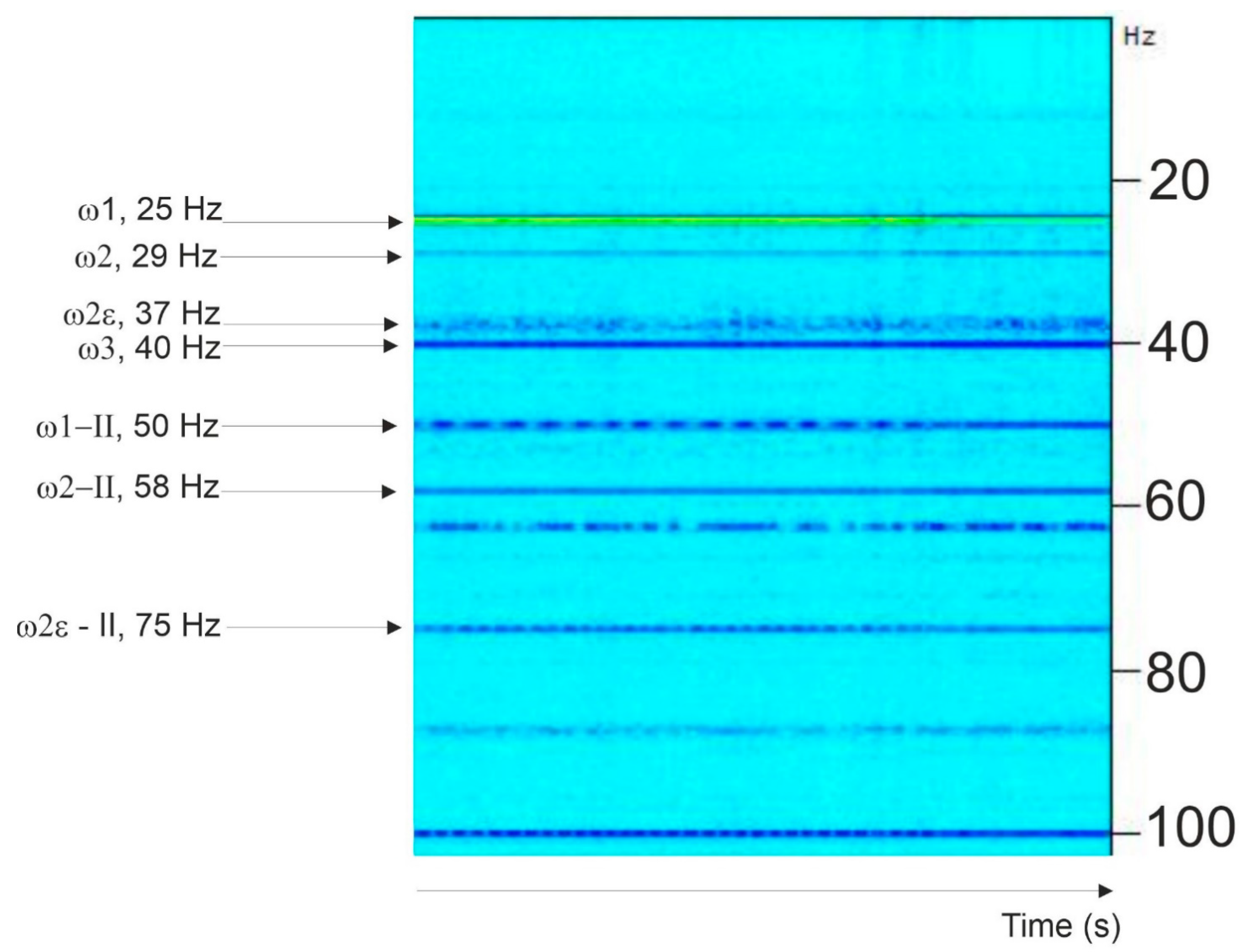
Appendix B
Appendix B.1. The PDF Analysis of Amorphous Materials
Appendix B.2. The Measurements of Enthalpies of −β Quartz Transitions and Gibbs Free Energy
References
- Heaney, P.J.; Prewitt, C.T.; Gibbs, G.V. Silica: Physical Behavior, Geochemistry, and Materials Applications. Rev. Miner. 1994, 29, 606. [Google Scholar]
- Richet, P.; Gillet, P. Pressure-induced amorphization of minerals: A review. Eur. J. Miner. 1997, 9, 907–934. [Google Scholar] [CrossRef]
- Nakamura, Y.; Muto, J.; Nagahama, H.; Shimizu, I.; Miura, T.; Arakawa, I. Amorphization of quartz by friction: Implication to silica-gel lubrication of fault surfaces. Geophys. Res. Lett. 2012, 39. [Google Scholar] [CrossRef]
- Goldsby, D.L.; Tullis, T.E. Low frictional strength of quartz rocks at subseismic slip rates. Geophys. Res. Lett. 2002, 29, 1844. [Google Scholar] [CrossRef]
- Di Toro, G.; Goldsby, D.L.; Tullis, T.E. Friction falls towards zero in quartz rock as slip velocity approaches seismic rates. Nature 2004, 427, 436–439. [Google Scholar] [CrossRef]
- Di Toro, G.; Hirose, T.; Nielsen, S.; Pennacchioni, G.; Shimamoto, T. Natural and Experimental Evidence of Melt Lubrication of Faults During Earthquakes. Science 2006, 311, 647–649. [Google Scholar] [CrossRef]
- Hayashi, N.; Tsutsumi, A. Deformation textures and mechanical behavior of a hydrated amorphous silica formed along an experimentally produced fault in chert. Geophys. Res. Lett. 2010, 37, L12305. [Google Scholar] [CrossRef]
- Hirose, T.; Shimamoto, T. Growth of molten zone as a mechanism of slip weakening of simulated faults in gabbro during frictional melting. J. Geophys. Res. Space Phys. 2005, 110, B05202. [Google Scholar] [CrossRef]
- Hirose, T.; Bystricky, M. Extreme dynamic weakening of faults during dehydration by coseismic shear heating. Geophys. Res. Lett. 2007, 34. [Google Scholar] [CrossRef]
- Tanaka, H.; Song, Y.F.; Chen, W.M.; Chen, Y.M.; Ma, K.F.; Liang, K.S. Dynamic Mechanochemistry of Seismic Slip from Chelungpu Fault, 01B1 SWLS-X-ray Microscopy; Int. Congress: Taiwan, China, 2012. [Google Scholar]
- Plescia, P.; Tempesta, E. Analysis of friction coefficients in a vibrating cup mill (ring mill) during grinding. Tribol. Int. 2017, 114, 458–468. [Google Scholar] [CrossRef]
- Di Toro, G. SHIVA, a Slow to High Velocity Apparatus Designed to Investigate Friction and Wear in Rocks and Materials; Texas A&M: College Station, TX, USA, 2012. [Google Scholar]
- Egami, T.; Billinge, S.J.L. Underneath the Bragg Peaks: Structural Analysis of Complex Materials; Pergamon Press, Elsevier: Oxford, UK, 2003. [Google Scholar]
- Dolino, G. The α-β transitions of quartz: A century of research on displacive phase transitions. Phase Transit. 1990, 21, 59–72. [Google Scholar] [CrossRef]
- Hemingway, B.S. Quartz: Heat capacity from 340 to 1000 °K and revised values for the thermodynamic properties. Am. Miner. 1987, 72, 273–279. [Google Scholar]
- Peng, Z.; Redfern, S.A.T. Mechanical properties of quartz at the α–β phase transition: Implications for tectonic and seismic anomalies. Geochem. Geophys. Geosyst. 2013, 14, 18–28. [Google Scholar] [CrossRef]
- Tromans, D.; Meech, J. Enhanced dissolution of minerals: Stored energy, amorphism and mechanical activation. Miner. Eng. 2001, 14, 1359–1377. [Google Scholar] [CrossRef]
- Cottrell, A.H. Dislocations and Plastic Flow in Crystals; Oxford University Press: London, UK, 1958. [Google Scholar]
- Yeganeh-Haeri, A.; Weidner, D.J.; Parise, J.B. Elasticity of α-Cristobalite: A Silicon Dioxide with a Negative Poisson’s Ratio. Science 1992, 257, 650–652. [Google Scholar] [CrossRef]
- Alderson, A.; Evans, K.E. Deformation mechanisms leading to auxetic behaviour in the α-cristobalite and α-quartz structures of both silica and germania. J. Phys. Condens. Matter 2008, 21, 025401. [Google Scholar] [CrossRef]
- Alderson, A.; Alderson, K.; Evans, K.E.; Grima, J.; Williams, M. Modelling of Negative Poisson’s Ratio Nanomaterials: Deformation Mechanisms, Structure-Property Relationships and Applications. J. Metastab. Nanocryst. Mater. 2005, 23, 55–58. [Google Scholar] [CrossRef]
- Ungár, T.; Borbély, A. The effect of dislocation contrast on x-ray line broadening: A new approach to line profile analysis. Appl. Phys. Lett. 1996, 69, 3173–3175. [Google Scholar] [CrossRef]
- Ungár, T.; Dragomir, I.; Révész, Á.; Borbély, A. The contrast factors of dislocations in cubic crystals: The dislocation model of strain anisotropy in practice. J. Appl. Crystallogr. 1999, 32, 992–1002. [Google Scholar] [CrossRef]
- Gubicza, J.; Szépvölgyi, J.; Mohai, I.; Zsoldos, L.; Ungár, T. Particle size distribution and dislocation density determined by high resolution X-ray diffraction in nanocrystalline silicon nitride powders. Mater. Sci. Eng. A 2000, 280, 263–269. [Google Scholar] [CrossRef]
- Sutapa, I.W.; Wahab, W.; Taba, P.; Nafie, N.L. Dislocation, crystallite size distribution and lattice strain of magnesium oxide nanoparticles. J. Phys. Conf. Ser. 2018, 979, 012021. [Google Scholar] [CrossRef]
- Brodie, K.H.; Rutter, E.H. Rapid stress release caused by polymorphic transformation during the experimental deformation of quartz. Geophys. Res. Lett. 2000, 27, 3089–3092. [Google Scholar] [CrossRef]
- Petkov, V. RAD, a program for analysis of X-ray diffraction data from amorphous materials for personal computers. J. Appl. Crystallogr. 1989, 22, 387–389. [Google Scholar] [CrossRef]
- Kleppa, O.; Hong, K. New applications of high-temperature solution calorimetry 1. Enthalpy of the diamond-to-graphite transformation and enthalpy of formation of Mn5C2 at 1320 K. J. Chem. Thermodyn. 1978, 10, 243–248. [Google Scholar] [CrossRef]
- Cheng, J.; Navrotsky, A. Enthalpies of formation of LaBO3 perovskites (B = Al, Ga, Sc, and In). J. Mater. Res. 2003, 18, 2501–2508. [Google Scholar] [CrossRef]
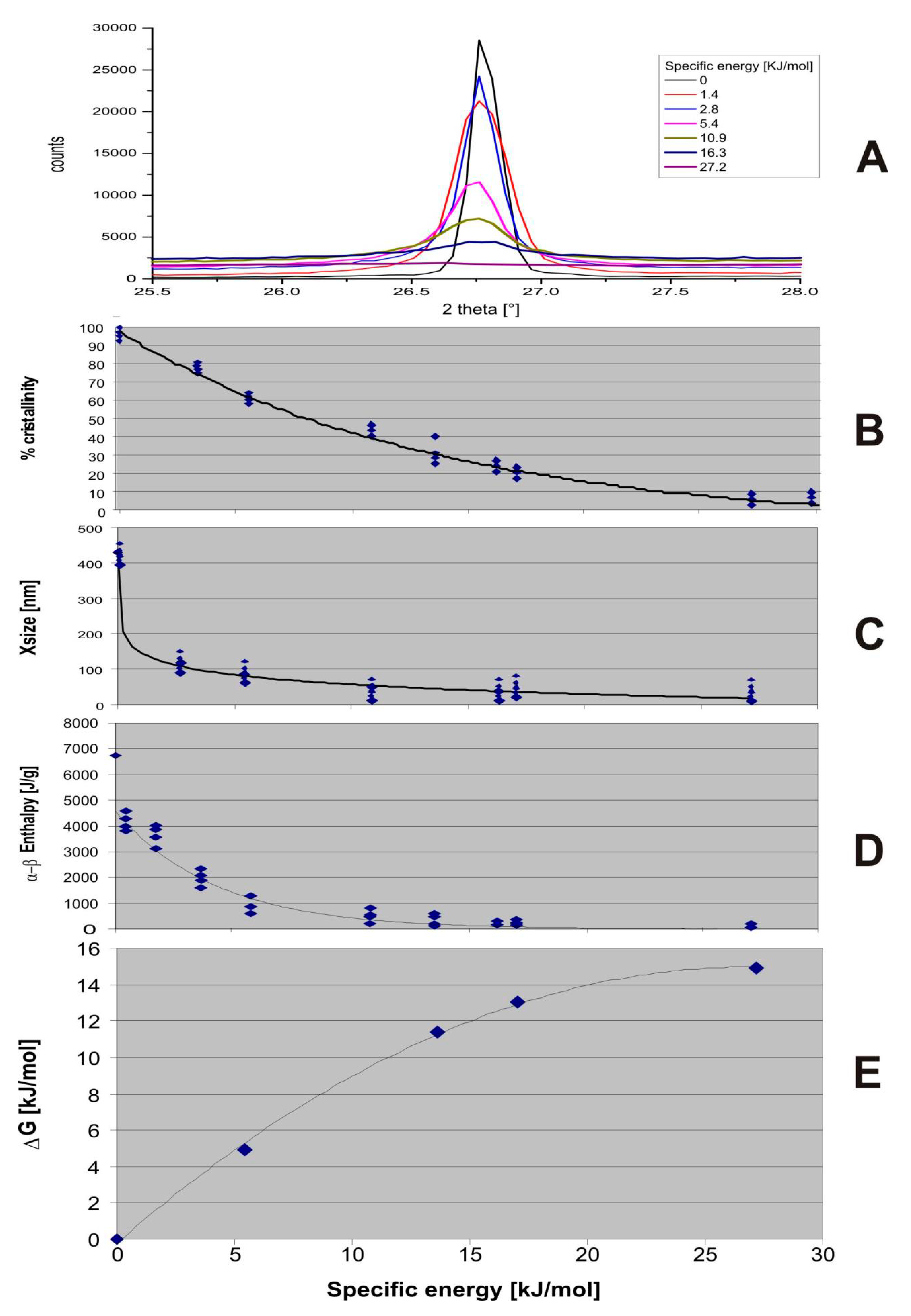
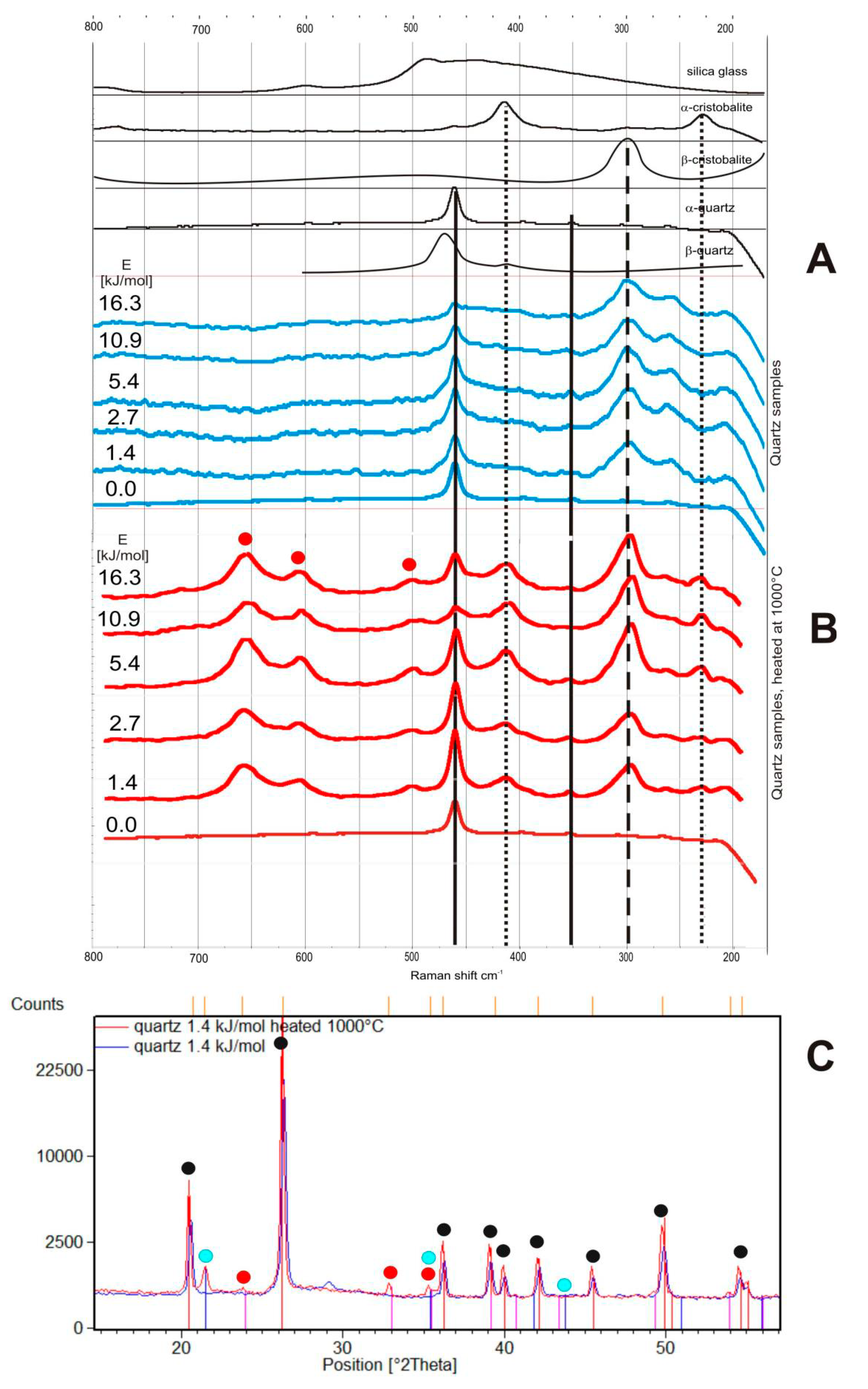
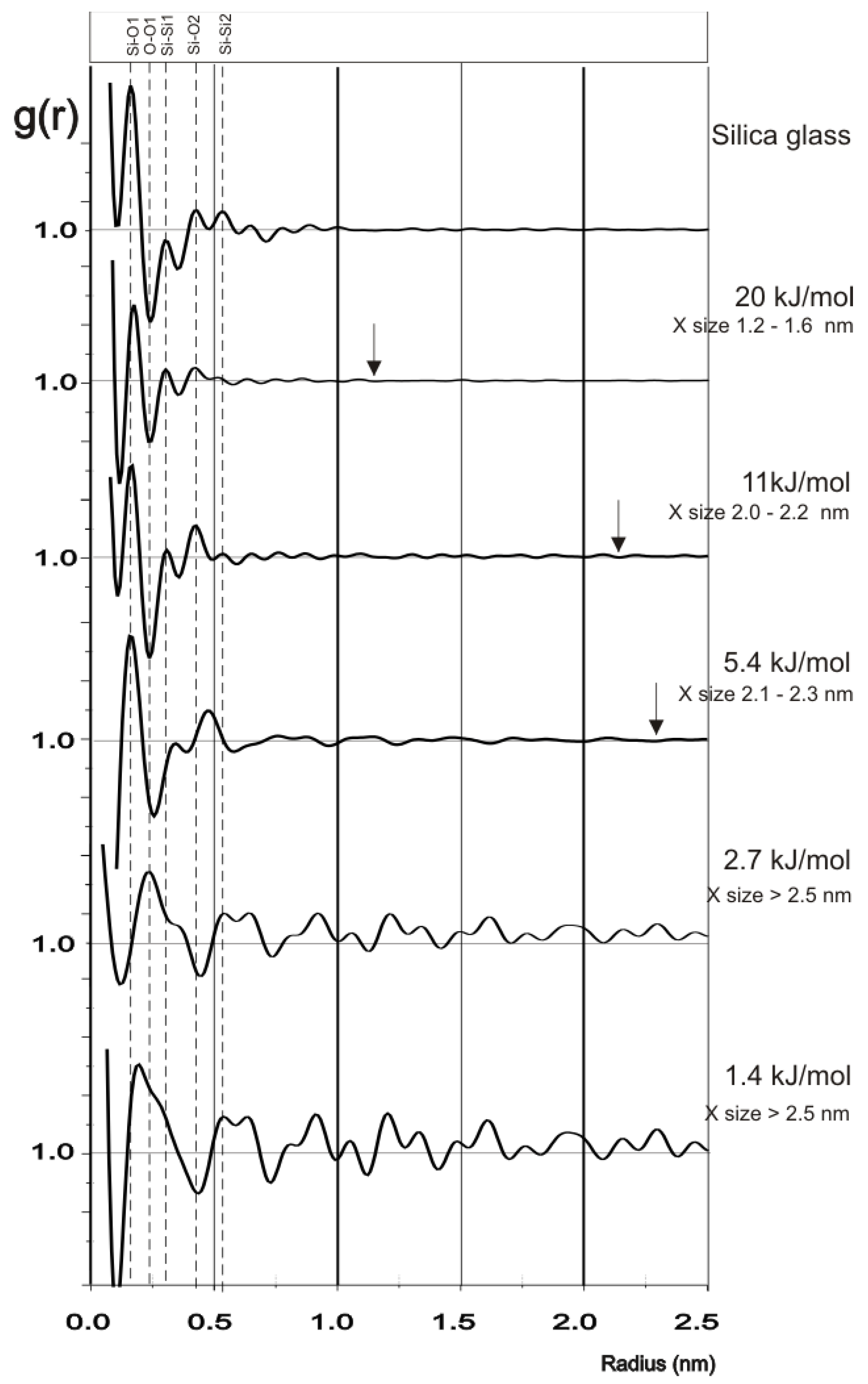
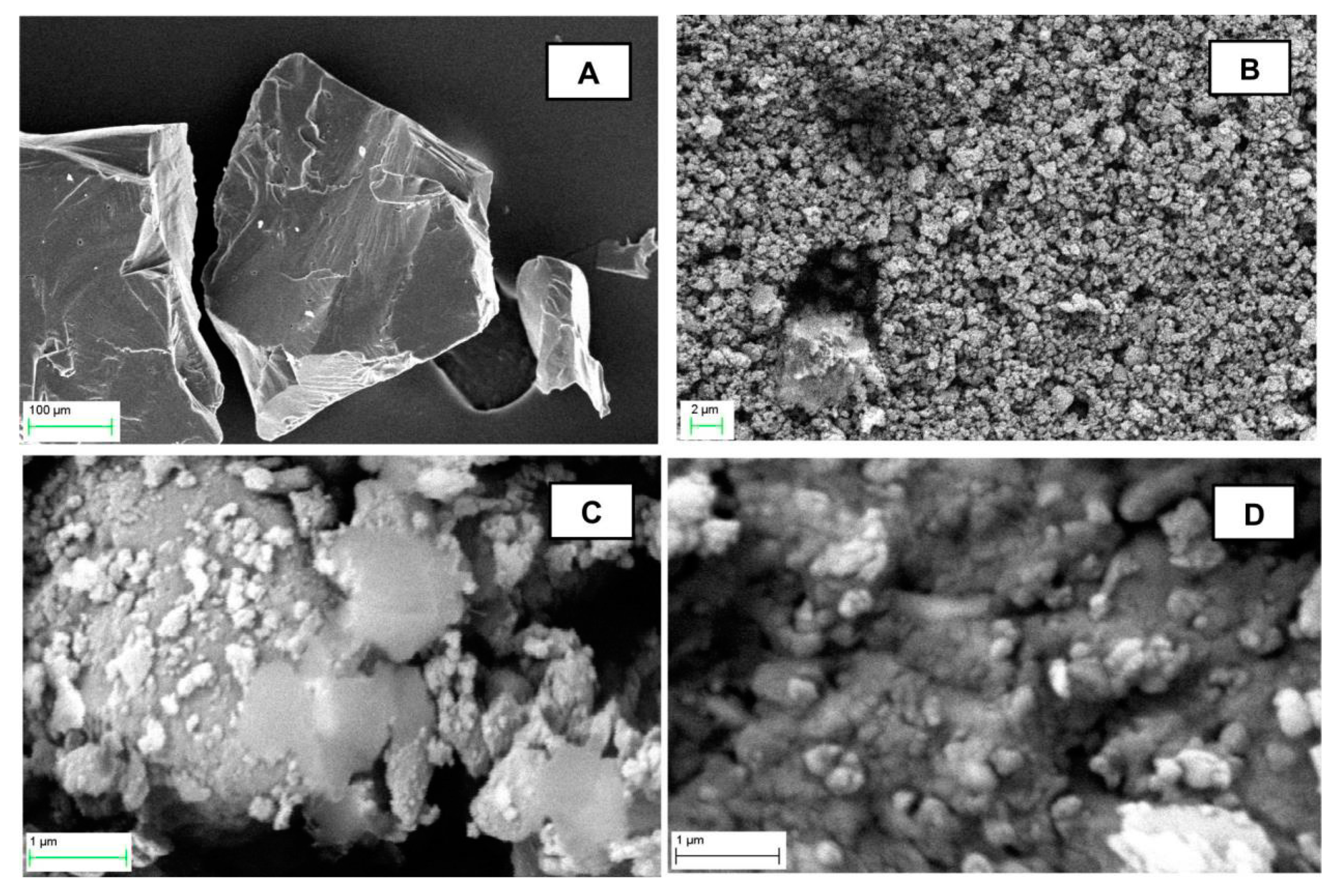
| Rotation Speed [RPM] | Grinding Mass Speed [m/s] | Slip Distances [m] | Slip Speed (1) [m] | Normal Stress [Mpa] | Shear Stress [Mpa] |
|---|---|---|---|---|---|
| 1000 | 6.5 | 4.7 | 2.2 | 129 | 76 |
| 1200 | 8.6 | 6.0 | 2.9 | 195 | 101 |
| 1500 | 10.6 | 7.2 | 3.5 | 279 | 110 |
| Time (Sec) | Specific Energy from Grinding (kJ/g) | Mean Friction Coefficient (Steel/Steel) | Mean Friction Coefficient (Steel/Quartz) |
|---|---|---|---|
| 540 | 6.1 | 0.08 | 0.48 |
| 1200 | 13.6 | 0.10 | 0.38 |
| 1400 | 15.8 | 0.17 | 0.37 |
| 1500 | 17.0 | 0.22 | 0.29 |
| 2820 | 31.9 | 0.52 | 0.18 |
© 2020 by the authors. Licensee MDPI, Basel, Switzerland. This article is an open access article distributed under the terms and conditions of the Creative Commons Attribution (CC BY) license (http://creativecommons.org/licenses/by/4.0/).
Share and Cite
Martinelli, G.; Plescia, P.; Tempesta, E. “Pre-Earthquake” Micro-Structural Effects Induced by Shear Stress on α-Quartz in Laboratory Experiments. Geosciences 2020, 10, 155. https://doi.org/10.3390/geosciences10050155
Martinelli G, Plescia P, Tempesta E. “Pre-Earthquake” Micro-Structural Effects Induced by Shear Stress on α-Quartz in Laboratory Experiments. Geosciences. 2020; 10(5):155. https://doi.org/10.3390/geosciences10050155
Chicago/Turabian StyleMartinelli, Giovanni, Paolo Plescia, and Emanuela Tempesta. 2020. "“Pre-Earthquake” Micro-Structural Effects Induced by Shear Stress on α-Quartz in Laboratory Experiments" Geosciences 10, no. 5: 155. https://doi.org/10.3390/geosciences10050155
APA StyleMartinelli, G., Plescia, P., & Tempesta, E. (2020). “Pre-Earthquake” Micro-Structural Effects Induced by Shear Stress on α-Quartz in Laboratory Experiments. Geosciences, 10(5), 155. https://doi.org/10.3390/geosciences10050155






